The Irish sealed a playoff berth with a wild win in Los Angeles, beating USC by a final score that was far more comfortable than the advanced stats (and lived experience). SP+ gives Notre Dame an adjusted margin of +5.7 points, the lowest in any game this season.
This game was definitely tight, but one where game state and flow matter a lot for how you interpret the final results. ND never trailed, and for long stretches Marcus Freeman’s group was consistently chipping away to carve out advantages across the board. Through 47 minutes (after USC punted early in the 4th quarter), Notre Dame was up two scores, had possession, and was +18% in success rate and +2.5 yards per play. The offense, aided by some trickery and clutch 4th down performance, had created a scoring opportunity on every possession where they hadn’t turned it over.

From that point, the Trojans furiously rallied, piling up 249 yards on 24 plays in the final 13 minutes! Unfortunately for Lincoln Riley, two of these long drives ended in pick-sixes and the final touchdown drive (5 plays, 75 yards) was all empty calories down 21 with time expiring. That final USC drive (and Notre Dame kneel down) are the only plays thrown out as garbage time in the numbers below.
The Irish offense holds serve
For much of 2024, the Notre Dame offense has felt like a complementary part to a dominant defense. The running game has been spectacular, for sure, but when things have gone sideways its typically been offensive droughts or mistakes creating friction. And in the biggest games before the regular season finale, it felt like the defense led the way, creating turnovers so the offense could do enough to seal the win.
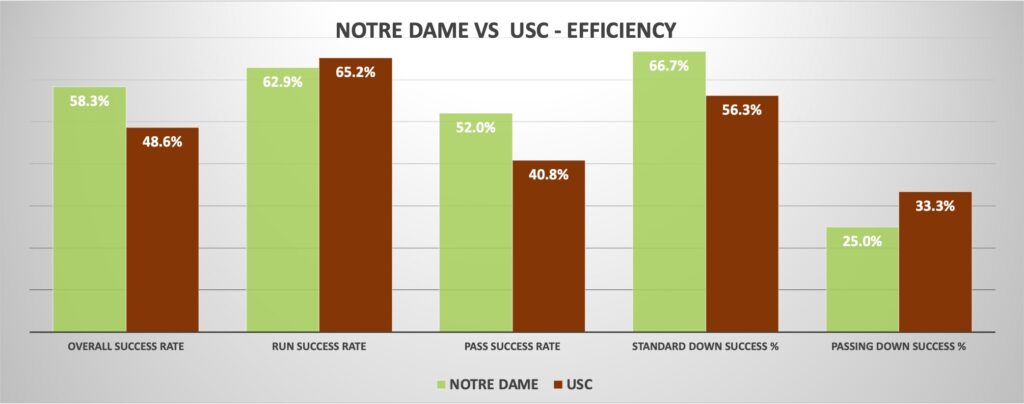
And while the late turnovers iced this game, it’s time to show more love to the Notre Dame offense for their performance in this game. The initial 14-point 4th quarter lead was built with strong offense, and the Irish generated six scoring chances on their first eight drives (and converted 5/6 into touchdowns). With the defense uncharacteristically getting beat downfield and struggling at times with communication, Mike Denbrock’s offense responded to every early USC touchdown with one of their own to stay in front.
The Trojans are much improved defensively – now 39th in Defensive F+ after finishing 100th a season ago, booting Alex Grinch, and hiring D’Anton Lynn. But the Irish still moved the ball with ease – especially on the ground, with an incredibly efficient 63% success rate (2nd highest on the season). Riley Leonard was sharp too, with strong passing efficiency and keeping the offense on schedule, facing only 12 passing downs on 60 plays.
This is realistically nearing the peak of what this Irish offense can look like – efficient and explosive on the ground, with the passing game providing a strong counterpunch. Notre Dame ran the ball on nearly 2/3 of early downs, but passed enough in key situations to keep the Southern Cal off balance. Obvious passing downs remain a challenge – the Irish were 0/5 on 3rd and 6+ yards (although one play was a 9-yard catch by Mitchell Evans that Riley Leonard barely converted on 4th down). But when running and passing were both on the table, the offense converted through the air on key downs including two 3rd and 4s and a 4th and 1 pass to Jordan Faison.
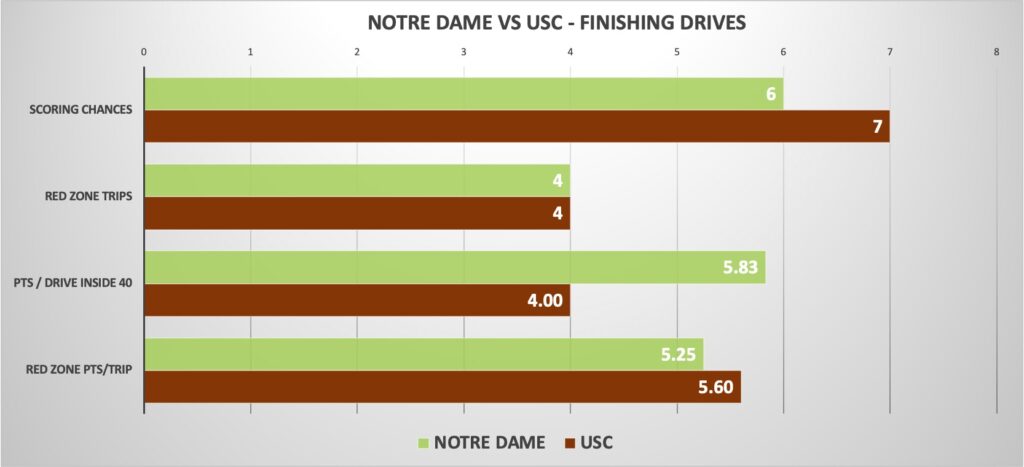
It wasn’t a perfect day – the passing game explosiveness is still the missing piece offensively, with just two gains of 20+ yards (fake punt excluded). It didn’t hurt the Irish in this game, but that efficiency isn’t sustainable game-to-game. It was a strong showing by the Notre Dame tight ends, and another up-and-down week for the receiving corps with Beaux Collins continuing to fade into the background and Jayden Thomas’ costly fumble. Still, this was a strong Denbrock formula, mixing in short rub routes and opportunities to get Leonard on the move with the dynamic running attack.
Wide receiver targets remain extremely spread out – Kris Mitchell led the way with four throws, then Jaden Greathouse and Jordan Faison and Jayden Thomas with two each, and just one for Beaux Collins. Look for Denbrock to continue to play the hot (or not cold) hands and matchups where he identifies advantages, especially with the rotation beyond Collins, Greathouse, and Faison. Meanwhile, Mitchell Evans put up his best performance of the year – 5 catches on 6 attempts thrown his way and 9.8 yards per target.
The Irish offense will finish the regular season 8th in Offensive F+, a pretty incredibly achievement. Preseason you’d assume this would have required some miracles on the offensive line, Riley Leonard to take a massive step forward as a passer, and likely some breakout wide receiver performances. The OL performance has been incredible but had to weather even more injuries, Leonard has been up-and-down before ending as a slightly upgraded passer over his Duke version, and the wide receiver performance has been a group effort without any true gamebreaker and lots of inconsistency. It turns out having great coordinators matters a whole lot!
Al Golden’s defense gets backed into the corner, then lands the knockout blow(s)
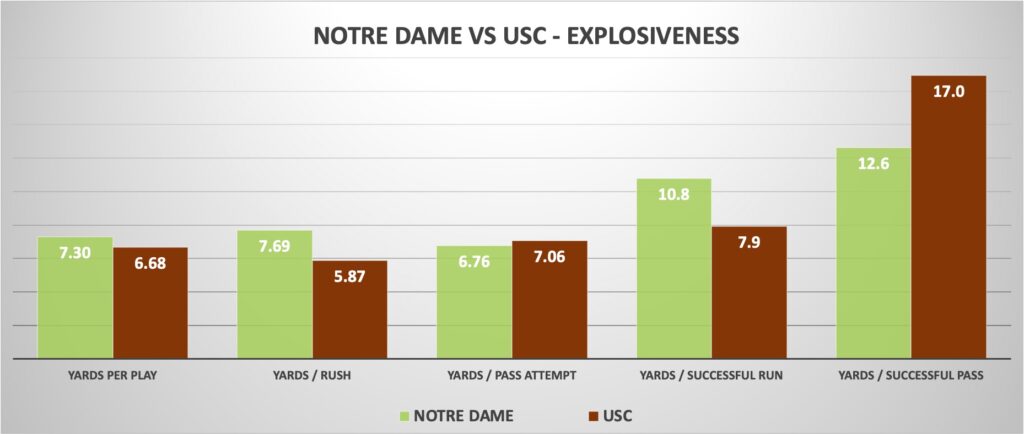
This strength on strength matchup when the Trojans had the ball was the juicy matchup heading into this game. After facing struggling passing attacks and the option-based service academies, how would the Irish deal with the QB and skill position talent they hadn’t seen anything like since Louisville?
There were definitely uncharacteristic struggles early and throughout against a well balanced SC offense. As he has all season, Lincoln Riley ran the ball sparingly (runs on just 35% of early downs) but very effectively (5.9 yards per carry, 65% success rate). The passing attack quickly moved from some underneath rub routes and screens into a downfield assault, with Jayden Maiava finishing with an average depth of target (aDOT) of 11.4 yards (Miller Moss’s season-high was 9.4).
Jayden Maiava was credited with six big-time throws in Saturday’s loss to Notre Dame, per PFF.
That’s more than Caleb Williams had in any game during his two seasons at USC.
— Ryan Kartje (@Ryan_Kartje) December 1, 2024
Maiava, for his part, was pretty excellent giving his blue chip receivers chances downfield. Golden’s defense demands that corners win on islands in man coverage, and they were challenged by SC’s combination of speedy receivers like Makai Lemon and big targets like JaKobi Lane and Duce Robinson. You all know the story by now – Christian Gray was the main victim (targeted 12 times for 130 yards) but came up clutch down the stretch. Leonard Moore was outstanding – giving up just 27 yards on 10 targets and breaking up 5 passes.
How concerned should the Irish be about the passing defense as they head into the playoffs? On one hand, Moore + Gray played every snap and were clearly exhausted by the end of the game, and Jordan Clark was banged up but returned. I think they’ll be in a better place both with rest and with home field advantage. USC’s bombs also weren’t as efficient as they felt – Maiava was 5 of 14 on throws 20+ yards downfield. It was concerted effort to go deep and try to create explosives after throwing just six of these deep passes against Nebraska and four against UCLA. These were quick heaves too – Maiava’s average time to throw was the least of any of his three starts despite these long passes.
In the end, I think it’s a “medium” concern. Notre Dame has faced two offenses with strong wide receiver rooms, and Louisville hit five passes of 20+ yards and USC created seven (all other opponents had 11 combined). Screening actions and long passes are probably better bets than alternatives against Golden’s defense, but you’ll also invite 3-and-outs and put the ball in danger (the Irish had 11 pass break-ups in this game, making them statistically unlucky to only come away with two interceptions).

Eye-test Check-In
Diving into a few observations and things that won’t show up in the numbers this week:
- Lincoln Riley is a gifted playcaller, but I truly don’t understand his offensive approach this year. The Trojans finished the regular season top 10 in EPA / rush and rushing success rate, yet threw the ball the 3rd most of any team in FBS.
- I don’t think Marcus Freeman has been asked about it, but this is several straight games with 3rd and long runs in scoring range that don’t gain much and set up missed field goals. I think the intent was actually to go for these 4th downs if more yards were gained (making it a 4th and 2-3 versus 4th and 6+). If that’s the case, I think it’s still worth going for it given the state of the kicking game, even if it’s a longer conversion than ideal.
- Chris Wilson of the Rakes Report was early on the theory that this Notre Dame offense struggles to figure out icing close and close-ish games offensively (see: Louisville, Georgia Tech, now USC). The obvious move is to lean into the ground game, but opponents know this too and can load up. In these late situations, Denbrock and company have struggled to call the good plays between failed attempts at kill shots or run-run-3rd and long passes. It’s worth monitoring should the Irish find themselves blessedly ahead late in a playoff game.

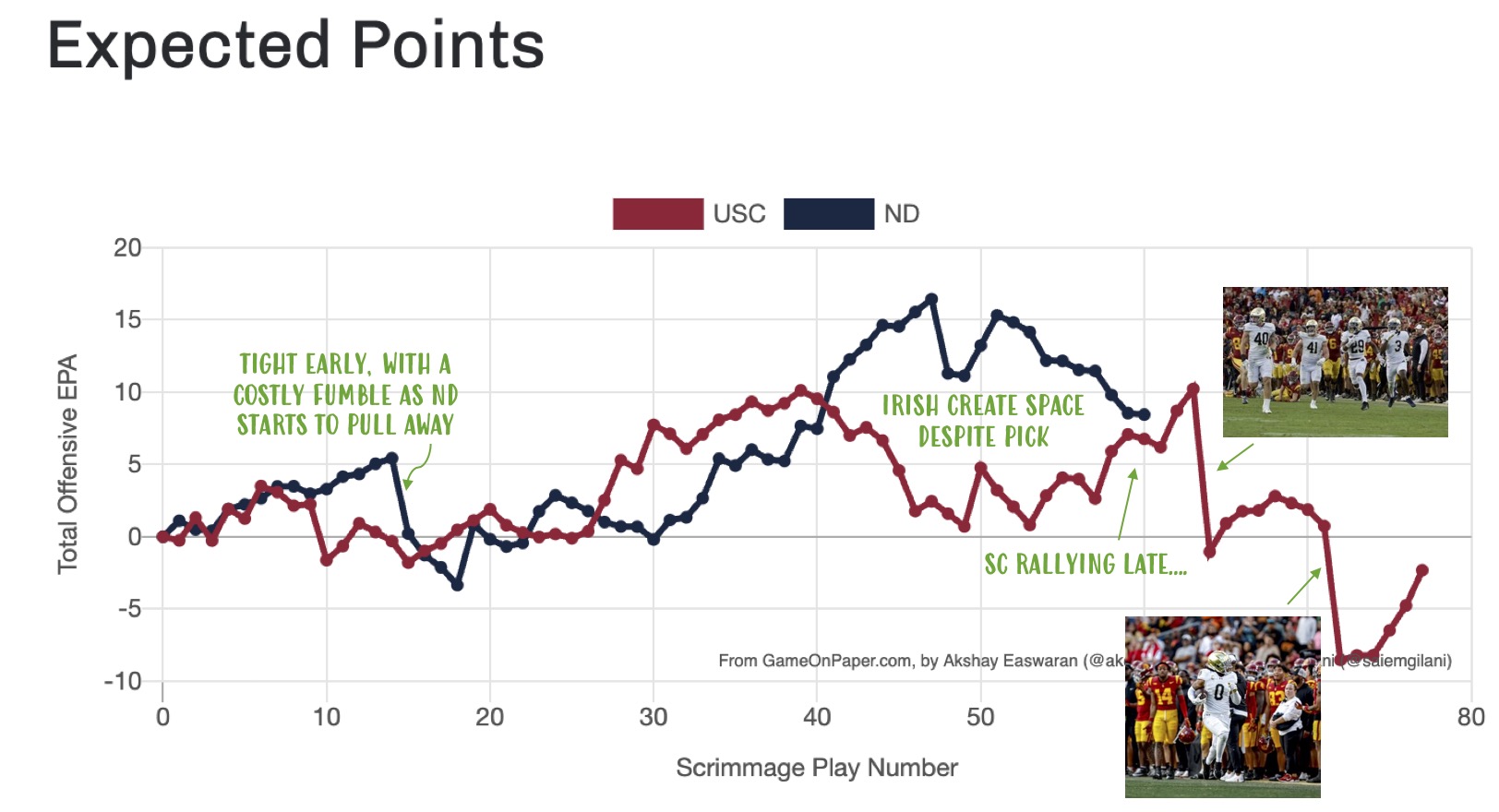

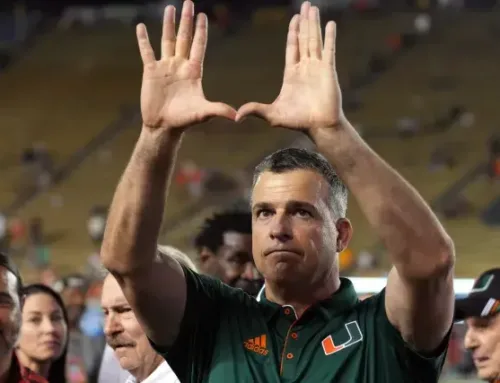
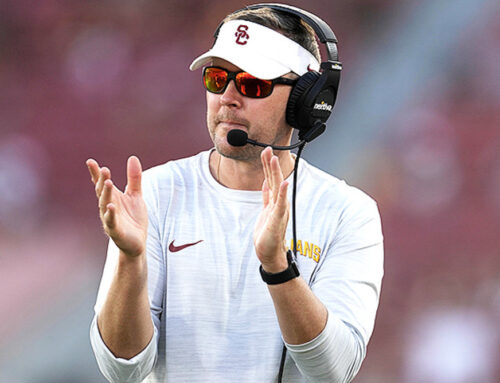
I think missing in Gray’s numbers given up were his penalties when he knew he’d been beat. As bad as his numbers look, they are actually worse, though could have been much worse if he wasn’t smart to interfere and avoid giving up the long touchdowns.
At least one of those was a great heads up play of gamesmanship for him. 15 yard penalty in CFB made it an easy penalty to take instead of getting beat for a TD.
To the very last point in this article, re: closing out games – Does it feel to anyone else like we’re completely missing out on play-action passing late in games? Would love to see plays that are designed for Leonard to fake a handoff and get outside the pocket. We used to run a little drag route with our TEs where Ian Book would get an easy layup for 6+ yards at pretty much any point in the game. Late, with the defense expecting run, plays like this should be open for even more yardage.
And then there’s the Alize Mack variation, where everyone drags but the TE or RB on the side the QB is rolling to slips out the back side.
If that’s done right, even a bad underthrow by Leonard would still be big yards.
I have to imagine Denbrock hasn’t forgotten about those…
8th in F+ offense huh? Any bets on what that would be if Tommy was still calling plays?
Rees 3 years as OC finished 16th in ’20, 12th in ’21, and 34th in ’22 in OF+